The perfect hard soap typically contains 30-40% hard oils (coconut and palm) balanced with softer oils like olive oil. Aim for combinations like 30% coconut oil, 30% palm oil, and 40% olive oil for ideal firmness and lather. Don't exceed 50% coconut oil to avoid over-cleansing. For sustainable options, consider RSPO-certified palm oil or alternatives like babassu. Your curing time will decrease with higher hard oil content, resulting in longer-lasting bars that customers love. The secrets to rock-solid soap await below.
What Oil Ratios Make The Perfect Hard Soap?
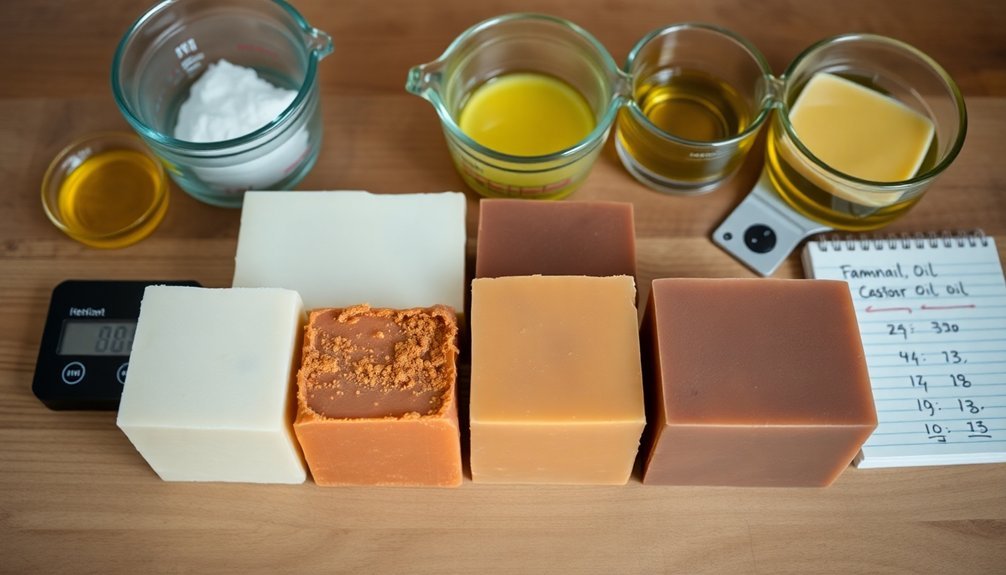
How exactly do you create a soap bar that's both hard enough to last and pleasant to use? The secret lies in balancing your oil ratios.
For an ideal hard soap, combine hard oils like coconut (15-50%) and palm oil (25-50%) with softer oils.
The popular 34/33/33 ratio (34% olive oil, 33% coconut oil, and 33% palm oil) creates a balanced bar with excellent lather and moisturizing properties.
When developing your soap recipe, aim for at least 30% hard oils to guarantee quick setting and easy unmolding.
For added luxury without sacrificing hardness, incorporate cocoa butter or shea butter in moderation.
Remember to balance your hard oils with 20-30% soft oils to prevent brittleness.
Adjusting your superfat amount can further fine-tune the bar's hardness while maintaining skin-friendly qualities.
Understanding Hard vs. Soft Oils in Soap Formulation
When formulating your soap recipe, distinguishing between hard and soft oils becomes essential for creating the perfect bar.
Hard oils like coconut oil and palm oil remain solid at room temperature and contribute greatly to your soap's firmness and longevity. These oils create abundant, fluffy lather while enhancing stability.
In contrast, soft oils such as olive oil remain liquid and typically yield softer soaps with different moisturizing characteristics.
The ideal soap formulation balances both types—using hard oils at 15-50% of your total recipe.
Finding the right ratio between hard and soft oils allows you to control your soap's hardness, lather quality, and moisturizing properties.
Too much of either can compromise your final product, so experiment with different combinations until you achieve your desired characteristics.
The 60/40 Rule: Balancing Hard and Soft Oils for Optimal Hardness
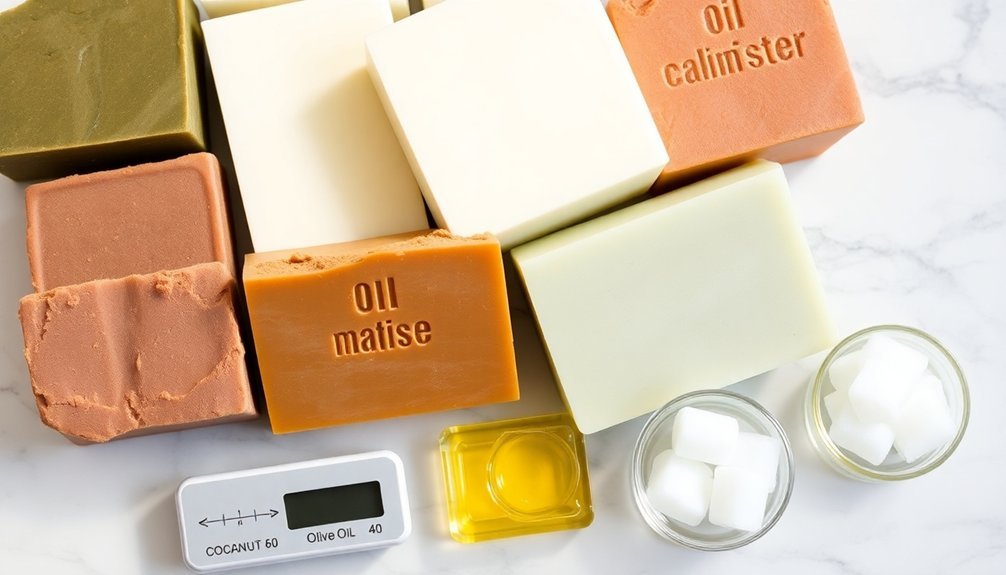
When you're formulating your soap recipe, following the 60/40 rule will help you achieve the perfect balance between firmness and moisturizing properties.
Your bars will cure more efficiently with 60% hard oils creating the structural integrity, while the 40% soft oils contribute essential skin-nourishing qualities.
You'll notice that this ratio not only produces consistently hard bars but also allows for customization within these parameters to suit your specific preferences for lather and conditioning.
Hard-Soft Oil Balance
Creating the perfect bar of soap requires careful attention to the balance between hard and soft oils in your recipe. The 60/40 rule offers an excellent starting point: aim for 60% hard oils like coconut oil and 40% soft oils like olive oil in your cold process soap formulations.
Hard oils contribute essential structure, creating firm bars that won't dissolve quickly in water. You'll want to include coconut oil at 15-50% of your recipe to achieve ideal soap hardness without sacrificing cleansing power.
Meanwhile, soft oils enhance your soap's moisturizing properties. Include olive oil at 25-80% to guarantee your bars remain gentle on skin while maintaining structural integrity.
This careful balancing of oil ratios directly influences not only your soap's firmness but also its lather quality and skin feel. Understanding these fatty acid profiles will help you customize recipes for your specific needs.
Optimal Curing Effects
Although beginners often focus on ingredient selection, the 60/40 ratio of hard to soft oils directly impacts your soap's curing process.
When you properly balance oil ratios, you'll notice your soap curing more efficiently, developing ideal saponification that enhances both firmness and longevity.
Hard oils like coconut and palm contribute to quicker hardening during curing, while soft oils maintain moisturizing properties throughout the process.
As you cure soap with balanced ratios, the molecular structure solidifies uniformly, resulting in a bar that won't become excessively hard or drying.
You'll find that soaps with properly balanced cleansing properties will continue developing superior lather quality during the 4-6 week curing period.
The 60/40 rule guarantees each ingredient fulfills its purpose—hard oils providing structure while soft oils contribute the nourishing elements your finished soap needs.
Key Fatty Acids That Contribute to Bar Firmness
The foundation of a firm, long-lasting soap bar lies in its fatty acid composition. When formulating your soap, you'll want to prioritize hard oils rich in specific fatty acids that enhance bar firmness.
Coconut oil and palm kernel oil contribute lauric acid, while palm oil provides both myristic and palmitic acids—all critical components for creating durable soap.
For peak bar hardness, focus on these three key fatty acids:
- Lauric acid – Creates hardness while generating abundant, cleansing lather
- Palmitic acid – Provides structure and stabilizes creamy lather
- Myristic acid – Improves firmness while contributing to fluffy lather
Remember to balance these hardening properties with moisturizing properties from softer oils in your soap formulation.
This equilibrium guarantees you'll create bars that are both firm and skin-friendly.
Coconut Oil Percentages: Finding the Sweet Spot for Hardness
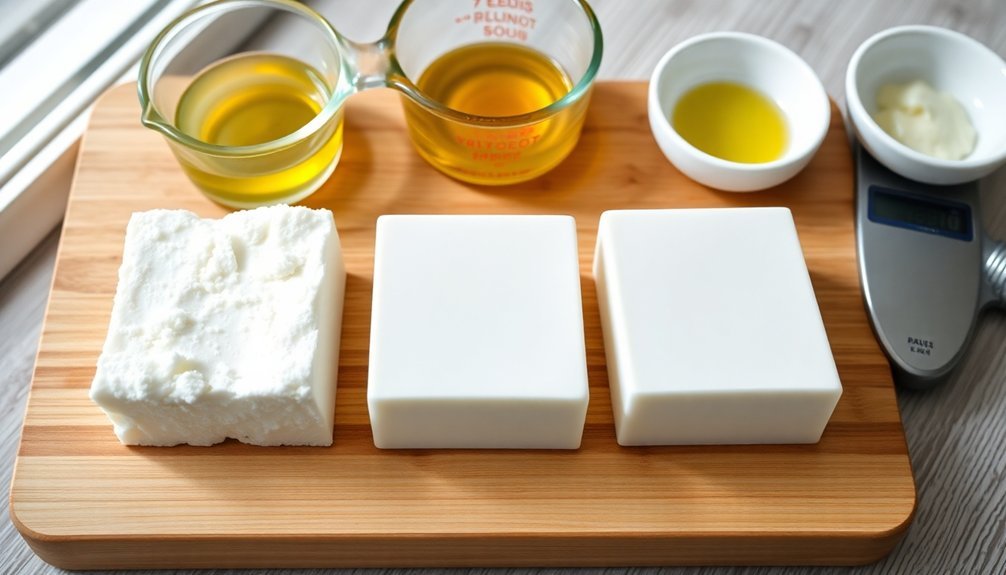
Coconut oil's unique profile makes it a powerhouse for creating hard bars with exceptional lather, but you'll need to find the right balance between the 15-50% range.
At around 30-40%, you'll hit the sweet spot where your soap maintains structural integrity while delivering that rich, cleansing foam your customers love.
Consider pairing your coconut oil with conditioning oils and adjusting your superfat level to create a perfectly balanced bar that's hard but won't strip the skin.
High-Lather Cleansing Balance
Finding the perfect coconut oil percentage represents one of the most critical balancing acts in soap making. While this powerful oil creates abundant bubbles and cleansing properties, too much leaves skin feeling tight and dry.
For high-lather hard soap, aim for 30% coconut oil in your formulating recipes, which strikes the ideal balance between cleansing strength and moisturizing benefits.
To maximize your soap's performance:
- Decrease your superfat percentage when using higher coconut oil ratios to enhance lather quality
- Pair coconut oil with palm oil or cocoa butter to maintain bar hardness
- Keep total coconut oil between 15-50%, adjusting based on your skin's sensitivity
The perfect oil ratios create a creamy lather that cleanses effectively without stripping natural oils—your key to crafting exceptional hard soap that customers will love.
Coconut's Hardening Properties
While many soapmakers focus exclusively on lather quality, coconut oil's exceptional hardening properties deserve equal attention in your formulations. When searching for that perfect rock-hard bar, coconut oil percentages between 15-50% will greatly contribute to your soap's structural integrity while delivering impressive cleansing properties.
| Coconut % | Hardness Effect | Moisturizing Balance |
|---|---|---|
| 15-25% | Moderate | Excellent |
| 25-35% | Strong | Good |
| 35-50% | Very Strong | Requires Higher Superfat |
For balanced bars, pair coconut oil with conditioning oils like olive oil or moisturizing butters. When using coconut oil at higher percentages, increase your superfat to at least 5% to counteract potential drying effects. This strategy maintains coconut's hardening benefits while preserving skin-friendly properties. Palm oil can also complement coconut oil's hardening abilities for especially firm soap recipes.
Optimal Ratios Chart
To achieve the perfect balance between hardness and conditioning properties in your soap, you'll need to carefully calibrate your coconut oil percentages.
The sweet spot typically falls between 15% and 50%, with most successful soap recipes hovering around 30%.
For rock-hard soap bars that won't dissolve quickly, consider these proven ratios:
- 30% coconut oil + 30% palm oil + 34% olive oil – Creates an ideal balance of hardness and conditioning
- 25% coconut oil + 35% hard oils (like shea butter) + 40% liquid oils – Excellent for long-lasting bars
- 15-20% coconut oil + 40% palm oil + 40% conditioning oils – Perfect for sensitive skin with adjusted superfat percentage
Remember that exceeding 50% coconut oil may produce extremely hard soap bars but risks creating an overly cleansing product that strips skin of natural oils.
Palm Oil and Sustainable Alternatives for Rock-Hard Bars
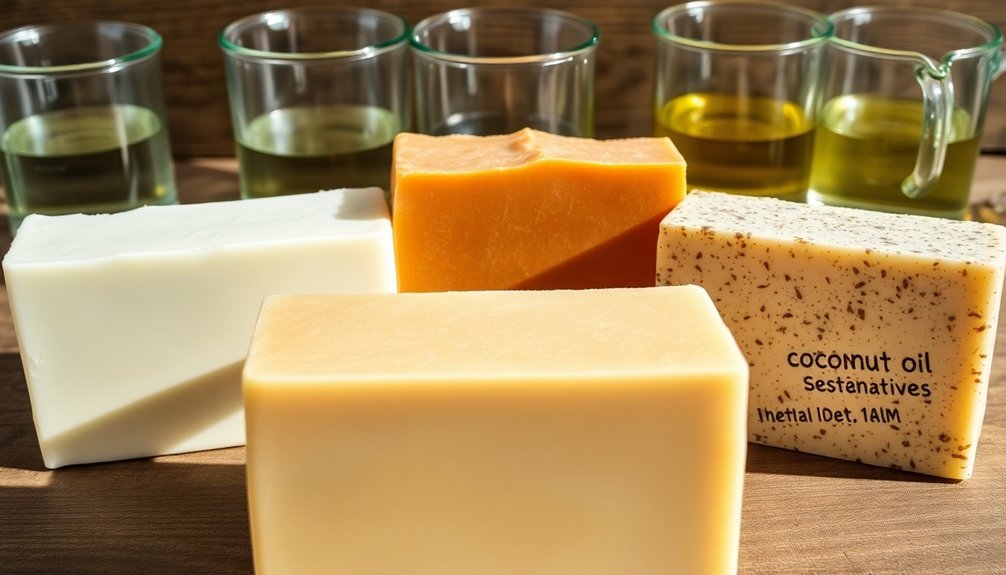
Although highly effective for creating rock-hard soap bars, palm oil remains a controversial ingredient due to environmental concerns.
When used at 25% to 50% in your soap recipes, it delivers exceptional hardness, stable lather, and improved longevity.
If you're concerned about ethical production, consider RSPO certified palm oil, which guarantees no contribution to deforestation or wildlife habitat destruction.
Alternatively, palm kernel oil and babassu oil offer similar hardness and cleansing benefits without the environmental baggage.
For best results, combine these hard oils in your formulations to achieve the perfect balance of firmness and lathering properties.
This approach lets you craft durable soap bars while maintaining sustainable practices.
Your customers will appreciate both the quality of your rock-hard bars and your commitment to ethical production.
Butters and Brittle Oils: How Much to Use for Maximum Firmness
Many soapmakers underestimate the remarkable impact that butters and brittle oils have on a soap's firmness.
To achieve peak hardness, incorporate cocoa butter and shea butter at 15-30% of your total oils in the soap recipe. These brittle oils not only enhance firmness but also add conditioning properties your customers will love.
For perfect oil ratios that create rock-hard bars, follow these guidelines:
- Include 15-30% butters (cocoa, shea) for structure and conditioning
- Add 15-50% coconut oil for hardness and robust lathering qualities
- Consider palm oil (25-50%) or sustainable alternatives for additional firmness
Balancing these components guarantees your soap maintains its shape while providing excellent lathering qualities.
Aim for 30-40% of your formula to come from hard or brittle oils for the ideal texture.
Curing Times and Their Impact on Soap Hardness
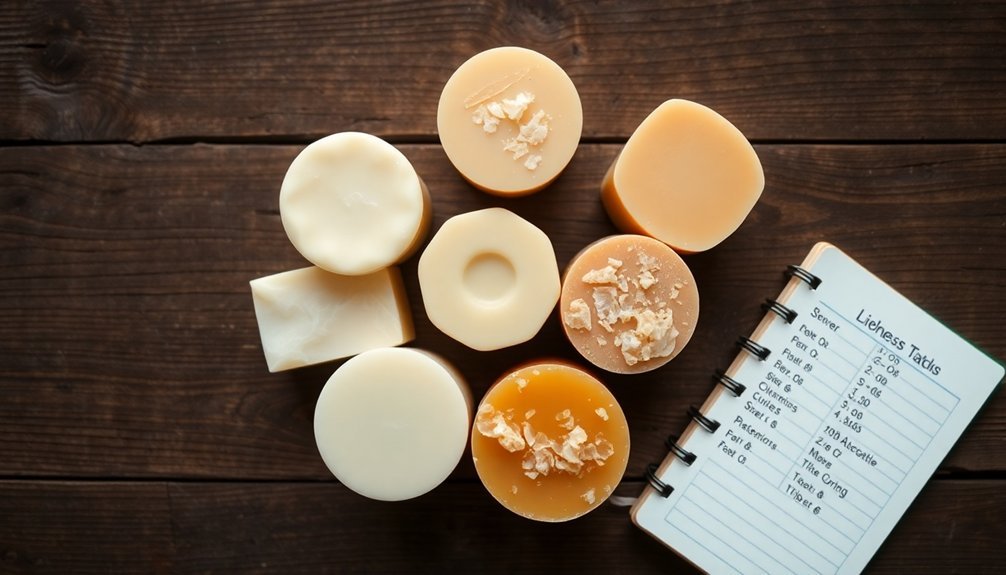
While crafting the perfect hard soap requires precise oil ratios, the curing process ultimately determines your final product's hardness.
You'll notice that soaps with higher percentages of hard oils like coconut oil, palm oil, and shea butter typically cure faster—often in just 4 weeks compared to 6 weeks for softer formulations.
Monitor your soap's moisture content during curing, as lower moisture levels contribute considerably to firmness.
Remember that each oil's saponification value affects how quickly your soap hardens, requiring adjustments to curing times for ideal results.
Don't rush the cutting soap stage. Instead, regularly test your soap's hardness throughout the curing period.
This patience pays off—properly cured bars last longer in the shower and provide better lather than their softer counterparts.
Frequently Asked Questions
What Oils Make the Hardest Soap?
You'll get the hardest soap by using coconut oil, palm oil, lard, or tallow. These hard oils work best at 25-50% in your recipe, especially coconut oil which creates rock-hard bars with abundant lather.
How to Increase the Hardness of Soap?
To increase your soap's hardness, incorporate more coconut or palm oil (30-50%), reduce soft oils like olive oil, and add sodium lactate during mixing. You'll get a rock-hard bar that lasts much longer.
What Is the Best Hardener for Soap Making?
For the best soap hardener, you'll find coconut oil and palm oil most effective. Use them at 30-50% of your recipe, or add cocoa butter for extra hardness with conditioning benefits.
What Is the Ratio of Oil in Soap Making?
In soap making, you'll find common ratios like 34/33/33 (olive/coconut/palm) or 30/30/30/10 (with a specialty oil added). You'll want hard oils to comprise 40-70% of your total oils for proper bar firmness.
In Summary
Your perfect hard soap depends on balancing oils properly. Aim for 60% hard oils (like palm, coconut, or butters) and 40% soft oils (like olive or sweet almond). Don't exceed 30% coconut oil to avoid dryness. Consider sustainable alternatives to palm if that's important to you. Remember, longer curing times (4-6 weeks minimum) will greatly improve your bar's hardness regardless of your oil ratio.

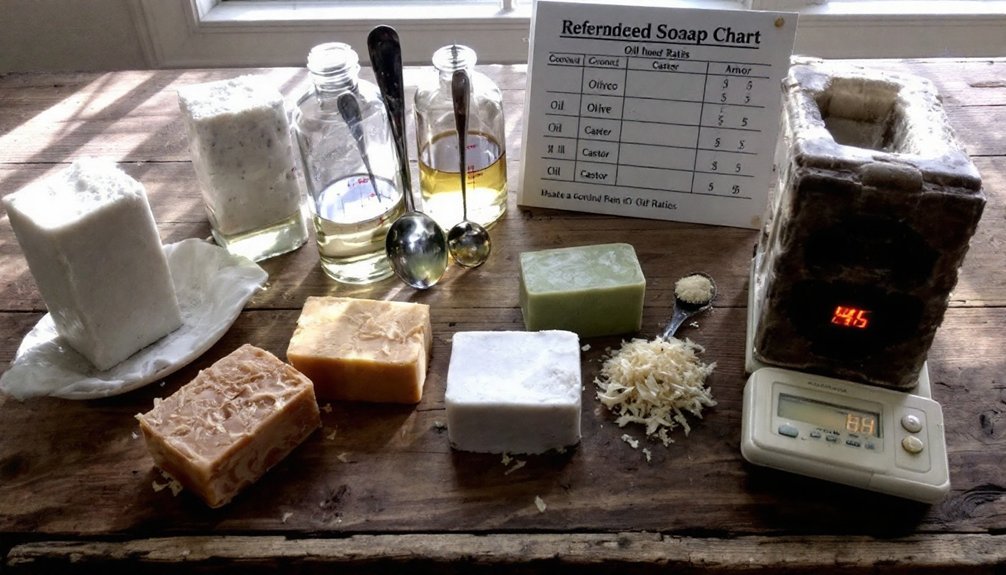



Leave a Reply